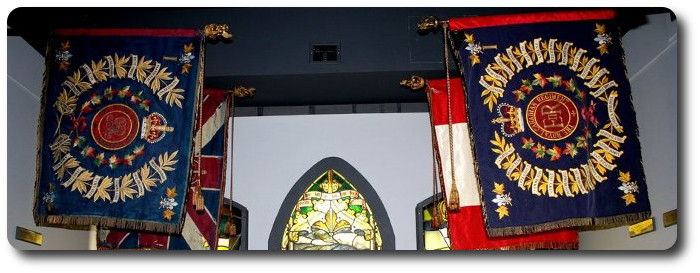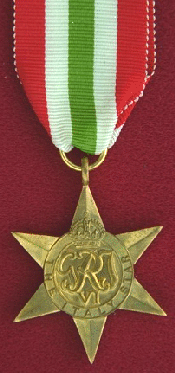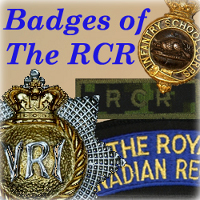
Researching The Royal Canadian Regiment
The Road To Campobasso
Being a Description of the Battles of Motta and Motta Ridge as Fought by The Royal Canadian Regiment, October 1-3, 1943.

The Italy Star was awarded for one day operational service in Sicily or Italy between 11 June 1943 and 08 May 1945.
By Major Strome Galloway, E.D.
The Connecting File; January 1947
The latter part of September, 1943, saw the initiative in Italy securely in the hands of the Allies. General Mark Clark's Anglo-American Fifth Army had broken out of the desperately contested Salerno beach-head and was almost in the act of capturing Naples and its environs. On the Adriatic' Coast elements of General Sir Bernard Montgomery's Eighth Army had raced through Foggia seeking to link up with a strongly-opposed seaborne assault which other elements of Eighth Army had mounted against Termoli. In the centre the 1st Canadian Division was preparing a two-pronged attack against the German stronghold in the Daunia Mountains-foothills of the formidable Appenine range.
Within the Daunias lay Campobasso, a fair-sized, modernized town which was said to be the headquarters of Field Marshal Albert Kesselring, commander of Tenth German Army, comprising the 14th and 76th Corps. Campobasso was akin to the hub of a wheel, and from this hub the German commander was soon to see the circumference of his "wheel of defence" crack and buckle under the pressure of the Allied attacks. The roads radiating from Campobasso were like so many spokes, and one by one these spokes pointing to the south, the south-east and the east were burned away by the Flames of War as the Winds of Victory blew them closer and closer to the hub.
One such spoke was that road which projected itself, so to speak, beyond the iron band at Motta Montecorvino, and in its prolongation ran as a smooth straight road across the western stretches of the Foggia Plain until it came to Lucera. This ancient town, once the capital of the Emperor Frederic Bavbarossa, was situated on top of a huge wedge of rock which looked from the distance for all the world like a great ploughshare poised to turn such a furrow as would swallow an entire army. Whether Lucera, which lay northwest. of Foggia, was clear of the enemy or not was undetermined, though as later events showed that the Boche had retreated along that prolongation until he came to Motta, at which point The Royal Canadian Regiment was destined to fight its first battle on the Italian mainland.
On the afternoon of September 30 a large all-arms conference took place in an orchard several miles from Canosa, a town on the south edge of the Foggia Plain. Here orders were given for the most spectacular prong of the two-pronged attack as mentioned above. The operation was to be in the form of an Advance Guard action across the Foggia Plain from Foggia to wherever the enemy might be contacted. The Advance Guard was to be composed of 1st Canadian Infantry Brigade and supporting arms. The second prong, coming in from the south was to feature 2nd Canadian Infantry Brigade, whereas 3rd Canadian Infantry Brigade, lately disengaged from fighting at Potenza - an operation carried out to alleviate the situation in the Salerno area-was to follow in the wake of 1st Brigade.
The Advance Guard, commanded by Lt.-Col. Neroutsos, 14th Canadian Tank Regiment, was composed of 4th Princess Louise Dragoon Guards, 14th Canadian Tank Regiment, The Royal Canadian Regiment, two half-sections of 1st Field Company, R.C.E., 2nd Field Regiment, RC.A., 66th Medium Regiment, R.A., 27th Light Anti-Aircraft Regiment, R.C.A., 27th Anti-Tank Battery, R.C.A., elements of the C.R.E.'s recce party, 214th Fighter Group Air Tentacle and 1st Canadian Infantry Brigade less The Royal Canadian Regiment.
The intention of 1st Canadian Division was to seize and hold the town of Campobasso and reorganize in that area; the intention of the Advance Guard was to seize and hold Campobasso until relieved. The plan was' to advance westward on a centre line-the main road Canosa - Foggia - Lucerna - Volturara - Vinchiatura, and thence north to Campobasso. Between Lucera and Volturara lay the hill-top village of Motta, now of historic significance in the annals of The Royal Canadian Regiment.
To achieve its intention the Advance Guard was further divided; into a Vanguard and a Mainguard. The vanguard was commanded by Lt.-Col. Adams, P.L.D.G., and was composed of 4th P.L.D.G., "C" Squadron 14th C.T.R, "B" Company and a section of the AntiTank Platoon R C. R, the two half-sections of the 1st Field Company, R.C.E., 10th Battery 2nd Field Regiment, RC.A., a F.O.O. from 2nd Field Regiment and a F.O.O. from, 66th Medium Regiment. The Mainguard, of course, consisted of the remainder of the Advance Guard.
The orders given to the vanguard were:
(1) Will carry out intention until stopped by enemy.
(2) Clear centre line of enemy small arms fire and mines, and will recce routes around demolitions and mark route.
(3) Carry out recce to limits (yellow lines): North of centre line - close; south of centre line - cursory.
That evening "B" Company, the Royal Canadian Regiment, and the section of the R.C.R. anti-tank platoon were detached from the battalion and in M.T. proceeded to an assembly area in a fringe of woods along the south edge of the Plain. About a quarter of a mile away in another clump of trees the remainder of the vanguard was in bivouac. A short co-ordinating conference was held in the twilight, and Lt.-Cot Adams gave orders for the vanguard to move off as a column at dawn. In "B" Company area sentries were posted, reliefs were told off, and the remainder of the company got down to the business of getting some sleep-an almost impossible task since the night was cold, the troops were still in summer drill, and gas-capes were the only shelter or bedding available.
The writer had the honour of commanding "B" Company, the three platoons being under the leadership of Lieut. D. G. Bagg, Lieut. I. G. Wilson and Lieut. G. Hyman. The anti-tank element of the R.C.R detachment was commanded by Sgt. F. Pendock.
At 0500 hours on October 1 the vanguard moved out of its harbour area according to plan, the various elements wheeling into their respective places in the column as it moved slowly forward. The armoured vehicles of the P.L.D.G. moved at the head of the column, ready to fan-out on both sides of the Centre Line and carry out their close or cursory searches as the case might be. "C" Squadron of the 14th C.T.R followed, and behind these battle monsters came "B" Company, the Company Commander in a borrowed P.L.D.G. carrier, followed by four T.C.V.'s, one containing Company Headquarters, each of the others containing a platoon. The anti-tank detachment of the RC.R tailed in behind, and the other elements of the vanguard brought up in the rear. The column moved quickly until it had passed through Foggia, by now bright daylight, then slowed down as the P.L.D.G. pushed cautiously through Lucera and out onto the Plain. From the high ground at Lucera the hazy outline of the Daunia Mountains could be seen ten miles to the west, and behind them the majestic peaks of the Appenines.
First contact with the enemy was made at 0830 hours when a squadron of the Dragoon Guards, commanded by Major Art Duck, came under small arms fire as they started up the spiral road leading into Motta. The Dragoon Guards, having found out what they sought—that the enemy had defensive positions on the Centre Line—quickly withdrew to the plain below and Major Duck established his, headquarters in a roadside farm. The tanks then attempted to farce their way through the winding street of the village, but the leading tank was put out of action and set afire by the defenders. They in their turn withdrew to the plain below.
While the early part of the action described above was being fought other squadrons of the Dragoon Guards were searching along parallel roads to the north and south, and the remainder of the column was making its way along the Centre Line, sometimes by the broad highway, and sometimes aver the fields, far several culverts had been blown by the Bache, making the road impassable to vehicles at these paints. By this time the tanks had reached the foot of the hill upon which Motta sat astride the Centre Line, however, all vehicles were an the highway and were halted about three miles east of Motta. Here the vanguard bagged dawn far several hours while the vanguard commander appraised the situation. Finally he decided that both the P.L.D.G. and the tanks could achieve nothing, and that Motta must be attacked with infantry. As a result of this decision he ordered the O.C. "B" Company, the Royal Canadian Regiment, to debuss his company and attack the hill-tap village. It must be explained at this time that one of "B" Company's platoons had been previously detached from the company, despite the protest of the company commander, and had been sent back along the road to Lucera, and thence northwest along the northern limit of the advance. Here it was to assist a squadron of the P.L.D.G. which had came under fire at Castelnauva, a village similar to Motta, but lying about four miles further north.
On receiving the order to attack the O.C. "B" Company decided to ride his two remaining platoons as far forward as possible, and after hurried instructions to the two platoon commanders the vehicles moved off, finally stopping about one mile from the tiny Nazi citadel, which frowned dawn an them from above. Debussing, the two platoons deployed according to orders and began moving across the rolling fields towards the foot of the rock-bound strongpoint, crossing and re-crossing the lower windings of the road which led to the top. Halfway up the slope the platoons halted in the pre-appointed farming-up place and awaited the arrival of the company commander who was tying in supporting fire with Major R G. Kingstone, O.C. of 10th Battery. By this time a Boche gun from high ground an the left flank was throwing the add shell at the debussing paint where company headquarters had been told to remain during the initial assault. A troop of "C" Squadron, 14th C.T.R., was detailed to assist the assault, being placed under command "B" Company, but the terrain was such that they could not give supporting fire and they were therefore ineffective.
Following a detailed plan the two platoons commenced their attack, but had hardly begun moving when the left platoon came. under the heaviest of machine-gun fire which mortally wounded the platoon commander (Lieut. Hyman) and caused other casualties among the men. The lay of the land was such that assault could only be made up two or three gullies covered by enemy M.G.'s or up ridges in full view of the enemy. The futility of a daylight attack was readily seen and the company commander decided to withdraw to a position some two hundred yards below and wait until dusk. Shells from 10th Battery began to land in the village but this did not silence the stuttering Spandaus, which appeared to be concealed just below the village boundary. Company Headquarters was moved up to the forward platoons, running the gauntlet of Boche shells, one of which whizzed right over the top of the T.C.V. used for the purpose of closing up.
It was now about 1800 hours and the entire Mainguard had closed up to within three or four miles of Motta. It had been decided by Advance Guard commander to mount an entire battalion attack and Lt.-Col. Spry, the battalion commander, had just finished his orders when O.C. "B" Company arrived back at Vanguard headquarters to report on the limited progress of the operation so far.
The plan was to leave "B" Company on its most forward line as a firm base from which "A" Company (Capt. T. M. Cantley), would move forward under cover of darkness and seize Motta. "C" Company (Capt. R. A. Couche) and "D" Company, (Major H. E. C. Price) were to take up position just below and to the right and left of "B" Company, so that the battle could be influenced from either flank if need be. Lt.-Col. Spry established his command post just to the rear of "B" Company, and set Zero Hour for 2300 hours. At the appointed time "A" Company began the ascent to Motta in single file along the winding road. The night was pitch black and the troops moved silently and without meeting opposition or fire until they reached the entrance of the village. They then began patrolling down the S-shaped one-and-only street of the place until caught in- the glare of the still-burning tank. All at once the enemy opened up with their Spandaus and the leading platoon commander, Lieut. R. E. A. Kerr, was wounded as were several of his men. For an hour or more
"A" Company and the defenders shot it out with small arms, but no progress was made, although two German prisoners were taken. 'The C.O. then detailed the O.C. "B" Company to go forward to Capt. Cantley's command post, confer with him and see if "B" Company and "A'" Company together could carry the village. This personal liaison was necessary due to the failure of wireless communication and the fact that the C.O. had been summoned back to Brigade Headquarters for a conference. "A" Company's command post was under constant small arms fire itself, but by keeping close to the walls the two company commanders were able to discuss the situation. It was decided that "A" Company should pull back down the hill a few hundred yards and that under cover of an artillery concentration the two companies would re-attack the town; "B" Company pushing up the main S-shaped street, while "A" Company attempted to enter the-place from the north. Actually this meant that "A" Company would do a right flanking movement while "B" Company pushed slowly into the town firing on the enemy and thereby causing a diversion.
This plan was passed on to the C.O. who agreed with the plan in general, and who then tied in the artillery and laid on the timings. One thing was clear, that Motta must be in the attackers' hands by First Light.
Shortly before Zero Hour a cloudburst commenced and this condition continued until the first streak of dawn appeared in the sky. The shelling set several buildings on fire, which blazed fiercely despite the rain, and' the attack was renewed. In order to expedite the action "B" Company was moved up the long, winding road almost to the top of the hill in T.C.V.'s halting less than three hundred yards down the hairpin road from the village entrance. The two. "B" Company platoons then debussed and moved up the winding street. In the meantime "A" Company had met with an unsurmountable obstacle-there was absolutely no entrance into Motta from the north, the buildings and walls: of the village having been built flush with a natural precipice so that a sheer fifty-foot wall presented itself to the troops.
Fortunately the enemy had begun to give way before "B" Company's pressure, and with the exchange of but a few shots culminated their rearguard action by a hurried embussment and a dash down the winding road on the far side of the village. The defenders made off in ten motor vehicles, headlights full on, and for a few minutes it was thought that they contained enemy reinforcements coming into the village, so winding was the road. As soon as it was ascertained that a withdrawal was taking place the foot-soldiers gave chase entering the village square just as the last vehicle was leaving. Fire was opened on the fleeing vehicles, and the anti-tank guns were hastily brought forward, but none of the enemy vehicles were halted by the fusilade.
The town was quickly consolidated and at First Light the code word for success, "Texas", was passed over the 18-set by O.C. "B" Company. Almost immediately the C.O. arrived at "B" Company H.Q. in the centre of the village, greeting the company commander with the words: "The mayor of Motta, I presume?" By this time the local inhabitants were emerging from their shelters surrounding the Canadians with thankful gestures and offering gifts of bread, eggs and wine. However, there was no time for victory celebrations, and Lt.-Col. Spry quickly despatched "C" Company through the village mounted on tanks to maintain contact with the retreating enemy. Within a short time "C" Company ran into heavy enemy fire, both mortar and small arms, and three of the tanks were knocked out. The company went to ground and continued to engage the enemy, losing about fifteen men as casualties. The 48th Highlanders had been ordered by the 1st Brigade to pass through the RC.R towards Volturara, but were unable to reach their assembly area in time. Therefore, by late afternoon, following a day marred by spasmodic enemy shelling of Motta, during which the Hastings and Prince Edward Regiment were preparing an attack on the right of the RC.R, the remainder of the RC.R was swung around to the south of the town and an attack was launched towards Motta Ridge some two thousand yards westward. Orders for this were received from Brigade late in the day and there was very little time left for reconnaissance and orders. The purpose of this attack was not only to seize the Ridge but also to assist "C" Company, RC.R., from the exposed position in which they had been held up and subjected to murderous mortar fire directed upon them from the Ridge.
"A,'" "B," and "D" Companies formed up for the attack just before dusk, the first and third named companies leading with "B" Company in reserve. Lt.-Col. Spry and his command group moved in the vicinity of the reserve company. The troops pushed forward over the rolling, gullied countryside in splendid order, but progress was slowed due to the huge clots of gluey mud which weighed down their boots. As the battalion kicked off' the artillery shelled the objective, while a troop of tanks in hull-down positions raked its lower slops with Besa fire. On arriving at the base of the objective without casualties, or indeed any response from the enemy, the two forward companies began climbing the ridge. By now it was pitch dark, and progress up the tangled slopes was exceedingly slow.
Along the base of the ridge ran a second-class road, and while "A" and "D" Companies were toiling their way up to the summit the C. O. and his command group crossed this road and positioned themselves in the far ditch. The reserve company remained on the near side. Suddenly a German half-track vehicle came hurtling down the road going due north. Close behind a volkswagon followed, also at a breakneck speed, the two of them passing between command group and the reserve company which were no more than thirty feet apart. So close to both groups were these vehicles and so fast did they travel that it was impossible to open fire on them. Shortly afterwards an explosion to the south bore out the contention that they contained a demolition party making an eleventh hour getaway.
In the meantime "A" and "D" companies had gained the top of the ridge only to come under extremely effective machine-gun fire. Later it was discovered that the Boche had rigged up wires among the undergrowth about a foot off he ground, and that when someone's leg touched one of these wires the guns opened up on fixed lines. Numerous casualties were caused, including O.C. "A" Company, Capt. T. M. Cantley, who was badly wounded in the shoulder, and Lieut. G. A. Slack, acting 2IC of "D" Company, who had insisted in joining in the attack, even though his duties did not make such a course necessary, and who was instantly killed. Despite this more-or-less ambush the leading companies drove the enemy off, captured a number of prisoners, and consolidated the ridge. At the same time "B" Company sent a platoon out to each flank and kept the remaining one along the road at the base of the ridge so that the position was completely secure.
With the coming of dawn it was seen that the enemy had entirely melted away to the westward. The bodies of the dead indicated that the defenders had been members of 1st Parachute Division. "C" Company soon closed up with the battalion from its old position, and by noon the 48th Highlanders and the Hastings and Prince Edward Regiment were moved up from reserve positions near Motta and were fanned out to the right and left of Motta Ridge so that 1st Brigade presented a broad front towards the enemy.
Campobasso still lay ahead, with considerable fighting in the offing. The next stage was the attack towards San Marco, another hill-top village some three miles to the west. 1st Canadian Division had its feet firmly planted on the road to Campobasso, and The R.C.R. was in the lead.


